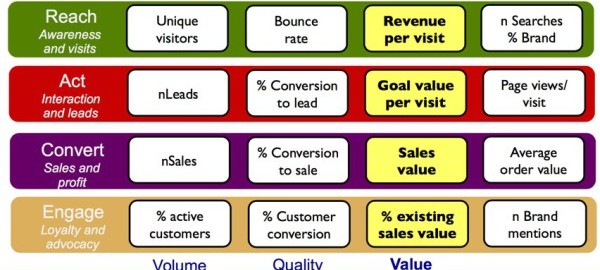At the MarTech conference in London, Columnist Ian Cleary summarizes a talk by Smart Insights’ Dave Chaffey on choosing the right measurements and tools for proving the value of content.

When was the last time you had a discussion about ROI for content marketing?
If you’re involved in content marketing, you probably have that conversation every day.
Dave Chaffey, CEO and co-founder of Smart Insights, presented on this topic at MarTech Europe in London this week.
Producing high-quality content on a consistent basis is a time-consuming and expensive process, and there’s an ever-increasing demand to show a return for this investment.
In research completed by Chaffey’s company in association with HubSpot, they found that 71% of businesses are creating more content in 2015 compared with 2014 — so the problem is growing!
Measurement Isn’t Just About Vanity Metrics
So with the increase in content and the number of new technologies jockeying for marketers’ attention, how do you choose the right kind of measurements and tools to understand your ROI in content marketing?
During his talk, Chaffey talked about the need to go beyond our traditional metrics of traffic, page views, and so on. These metrics are useful, but not in isolation.
He shared as an example a car insurance company which found that for a customer to make a decision about vehicle insurance her online customer journey involved:
- Five websites
- Nine visits
- Over 35 days
- Across multiple devices
- Spending 45 minutes doing the research
To accurately measure our conversion through content, we need to understand the full customer journey, from an idea to a purchase.
We also need to accurately measure and budget for the costs involved in content marketing.
Chaffey pointed to some examples from a Contently study of the level of resources/costs going into content marketing for larger companies:
- Red Bull employs 135 people in their media house
- Nestle’s digital editorial team consists of almost 20 community managers and designers producing content every day.
- Coca-Cola now reportedly spends more money creating its own content than it does on TV advertising
7 Essential Techniques For Proving The Value Of Content
Chaffey outlined seven techniques his team uses for proving the value of content:
- Dashboards — Create a filtered view of your data through dashboards that can be shared across your organization.
- Volume — Segment your data to get a filtered view of traffic based on channel.
- Page value — Set up goals for your actions on blog content and assign a value to these goals.
- Revenue per visit — Track revenue generated from each visit by channel.
- Attribution — Define your model for attribution and track this using tools such as Google Analytics and Kissmetrics.
- ROI calculations — Calculate ROI from a top level but also from individual content pieces.
- Tools — Use appropriate tools for social media amplification and influencer outreach.
To implement the correct measurement, he uses their proprietary framework called “RACE.” This is used to help digital marketers become more effective with their marketing.
For measurement of digital marketing activities, Chaffey outlined what should be measured for each stage of RACE (reach, act, convert and engage).

If you use Google Analytics, you’ll need to segment your audience based on each channel so you can assess performance of content assets by source of traffic.
He also recommended using assisted conversion multi-channel funnel reports.
As seen in an earlier example, customers may visit your site multiple times and from various places before they make a decision to purchase.
So we need to find out where they came from for each visit, and then decide on which channel we’re going to assign the sale to.
Summary
Content marketing is an expensive, but potentially lucrative, activity. Without proper measurements in place, you’re wasting opportunities for generating more revenue from this effort.
Chaffey gave us an outline of the type of measurement he thinks you should be considering. What’s your opinion?
Here’s Chaffey’s full presentation:
Some opinions expressed in this article may be those of a guest author and not necessarily Marketing Land. Staff authors are listed here.
(Some images used under license from Shutterstock.com.)
Marketing Land – Internet Marketing News, Strategies & Tips
(140)
Report Post







